Using Linear Mixed-Effects Models with Quantile Regression to Simulate the Crown Profile of Planted Pinus sylvestris var. Mongolica Trees
Abstract
:1. Introduction
2. Materials and Methods
2.1. Study Area and Data Collection
2.2. Data Collection and Analysis
2.3. Model Selection for the Crown Profile
2.4. Quantile Regression for the Mixed-Effects Outer Crown Profile Model
3. Results
3.1. Best Model Selection for the Crown Profile Model
3.2. Quantile Regression for the Linear Mixed-Effects Crown Profile Model
3.3. Effect of Stand Age and Stand Density on the Crown Profile
4. Discussion
5. Conclusions
Acknowledgments
Author Contributions
Conflicts of Interest
References
- Hansen, A.J.; Spies, T.A.; Swanson, F.J.; Ohmann, J.L. Conserving biodiversity in managed forests: Lessons from natural forests. BioScience 1991, 41, 382–392. [Google Scholar] [CrossRef]
- Ishii, H.; McDowell, N. Age-related development of crown structure in coastal Douglas-fir trees. For. Ecol. Manag. 2002, 169, 257–270. [Google Scholar] [CrossRef]
- Fichtner, A.; Sturm, K.; Rickert, C.; Oheimb, G.V.; Härdtle, W. Crown size-growth relationships of European beech (Fagus sylvatica L.) are driven by the interplay of disturbance intensity and inter-specific competition. For. Ecol. Manag. 2013, 302, 178–184. [Google Scholar] [CrossRef]
- Mawson, J.C.; Thomas, J.W.; DeGraaf, R.M. Program HTVOL: The Determination of Tree Crown Volume by Layers; Research Paper NE-354; U.S. Department of Agriculture, Forest Service, Northeastern Forest Experiment Station: Philadelphia, PA, USA, 1976.
- Biging, G.S.; Wensel, L.C. Estimation of crown form for six conifer species of northern California. Can. J. For. Res. 1990, 20, 1137–1142. [Google Scholar] [CrossRef]
- Baldwin, V.C., Jr.; Peterson, K.D. Predicting the crown shape of loblolly pine trees. Can. J. For. Res. 1997, 27, 102–107. [Google Scholar] [CrossRef]
- Hann, D.W. An adjustable predictor of crown profile for stand-growth Douglas-fir trees. For. Sci. 1999, 45, 217–225. [Google Scholar]
- Raulier, F.; Ung, C.-H.; Ouellet, D. Influence of social status on crown geometry and volume increment inregular and irregular black spruce stands. Can. J. For. Res. 1996, 26, 1742–1753. [Google Scholar] [CrossRef]
- Crecente-Campo, F.; Marshall, P.; Lemay, V.; Diéguez-Aranda, U. A crown profile model for Pinus radiata D. Don in Northwestern Spain. For. Ecol. Manag. 2009, 257, 2370–2379. [Google Scholar] [CrossRef]
- Crecente-Campo, F.; Álvarez-González, J.G.; Castedo-Dorado, F.; Gómez-García, E.; Diéguez-Aranda, U. Development of crown profile models for Pinus pinaster Ait. and Pinus sylvestris L. in northwestern Spain. Forestry 2013, 86, 481–491. [Google Scholar] [CrossRef]
- Gao, H.L.; Bi, H.Q.; Li, F.R. Modeling conifer crown profiles as nonlinear conditional quantiles: An example with planted Korean pine in northeast China. For. Ecol. Manag. 2007, 398, 101–115. [Google Scholar] [CrossRef]
- Dong, C.; Wu, B.G.; Wang, C.D.; Guo, Y.R.; Han, Y.H. Study on crown profile models for Chinese fir, in Fujian Province and its visualization simulation. Scand. J. Forest. Res. 2016, 31, 1–32. [Google Scholar] [CrossRef]
- Guo, Y.R.; Wu, B.G.; Zheng, X.X.; Zheng, D.X.; Liu, Y.; Dong, C.; Zhang, M.B. Simulation model of crown profile for Chinese fir (Cunninghamia lanceolata) in different age groups. J. Beijing For. Univ. 2015, 37, 40–47. (In Chinese) [Google Scholar]
- Ritchie, M.W.; Hann, D.W. Equations for Predicting Height to Crown Base for Fourteen Tree Species in Southwest Oregon; Research Paper 50; Forest Research Lab., Oregon State University: Corvallis, OR, USA, 1987. [Google Scholar]
- Gao, H.L.; Dong, L.H.; Li, F.R. Modeling Variation in Crown Profile with Tree Status and Cardinal Directions for Planted Larix olgensis Henry Trees in Northeast China. Forests 2017, 8, 139. [Google Scholar]
- Hao, L.; Naiman, D. Quantile Regression. In Statistics for Social Science and Behavorial Sciences; Sage Publications, Inc: London, UK, 2007. [Google Scholar]
- Wackerly, D.D.; Mendenhall, W., III; Scheaffer, R.L. Mathematical Statistics with Applications; Thomson Learning, Inc: Belmont, USA, 2008. [Google Scholar]
- Rao, C.R.; Toutenburg, H.; Shalabh Heumann, C. Linear Models and Generalizations: Least Squares and Alternatives; Springer: Berlin, Germany, 2008. [Google Scholar]
- Koenker, R.; Bassett, G. Regression quantiles. Econometrica 1978, 46, 33–50. [Google Scholar] [CrossRef]
- Koenker, R. Quantile Regression; Cambridge University Press: Cambridge, UK, 2005. [Google Scholar]
- Koenker, R.; Machado, J.A.F. Goodness of fit and related inference process for quantile regression. J. Am. Stat. Assoc. 1999, 94, 1296–1309. [Google Scholar] [CrossRef]
- Zhang, L.; Bi, H.; Gove, J.H.; Heath, L.S. A comparison of alternative methods for estimating the self-thinning boundary line. Can. J. For. Res. 2005, 35, 1507–1514. [Google Scholar] [CrossRef]
- Cade, B.S.; Noon, B.R. A gentle introduction to quantile regression for ecologists. Front. Ecol. Environ. 2003, 1, 412–420. [Google Scholar]
- Evans, A.M.; Finkral, A.J. A new look at spread rates of exotic diseases in North American forests. For. Sci. 2010, 56, 453–459. [Google Scholar]
- Haile, G.A.; Nguyen, A.N. Determinants of academic attainment in the United States: A quantile regression analysis of test scores. Educ. Econ. 2008, 16, 29–57. [Google Scholar] [CrossRef] [Green Version]
- Austin, P.C.; Schull, M.J. Quantile regression: A statistical tool for out-of hospital research. J. Soc. Acad. Emerg. Med. 2003, 10, 789–797. [Google Scholar] [CrossRef]
- Engle, R.F.; Manganelli, S. CAViaR: Conditional Value at Risk by Quantile Regression; Working Paper No. 7341; National Bureau of Economic Research: Cambridge, UK, 1999. [Google Scholar]
- Machado, J.A.F.; Mata, J. Counterfactual decomposition of changes in wage distributions using quantile regression. J. Appl. Econ. 2005, 20, 445–465. [Google Scholar] [CrossRef]
- Cade, B.S.; Noon, B.R.; Flather, C.H. Quantile regression reveals hidden bias and uncertainty in habitat models. Ecology 2005, 86, 786–800. [Google Scholar] [CrossRef]
- Mehtätalo, L.; Gregoire, T.G.; Burkhart, H.E. Comparing strategies for modeling tree diameter percentiles from remeasured plots. Environmetrics 2008, 19, 529–548. [Google Scholar] [CrossRef]
- Ducey, M.J.; Knapp, R.A. A stand density index for mixed species forests in the northeastern United States. For. Ecol. Manag. 2010, 260, 1613–1622. [Google Scholar] [CrossRef]
- Bohora, S.B.; Cao, Q.V. Prediction of tree diameter growth using quantile regression and mixed-effects models. For. Ecol. Manag. 2014, 319, 62–66. [Google Scholar] [CrossRef]
- Gao, H.L.; Dong, L.H.; Li, F.R. Maximum density-size line for Larix olgensis plantations based on quantile regression. Chin. J. Appl. Ecol. 2016, 27, 3420–3426. (In Chinese) [Google Scholar]
- Fuzi, M.F.M.; Jemain, A.A.; Ismail, N. Bayesian quantile regression model for claim count data. Insur. Math. Econ. 2016, 66, 124–137. [Google Scholar] [CrossRef]
- De-Miguel, S.; Mehtätalo, L.; Shater, Z.; Kraid, B.; Pukkala, T. Evaluating marginal and conditional predictions of taper models in the absence of calibration data. Can. J. For. Res. 2012, 42, 1383–1394. [Google Scholar] [CrossRef]
- Geraci, M.; Bottai, M. Quantile regression for longitudinal data using the asymmetric Laplace distribution. Biostatistics 2007, 8, 140–154. [Google Scholar] [CrossRef] [PubMed]
- Galarza, C.E.; Lachos, V.H. Likelihood based inference for quantile regression in nonlinear mixed effects models. Estadística 2015, 67, 188–189. [Google Scholar]
- Liu, Y.; Bottai, M. Mixed-effects models for conditional quantiles with longitudinal data. Int. J. Biostat. 2009, 5, 28. [Google Scholar] [CrossRef]
- Chen, X.; Tang, N.; Zhou, Y. Quantile regression of longitudinal data with informative observation times. J. Multivar. Anal. 2016, 144, 176–188. [Google Scholar] [CrossRef]
- Marino, M.F.; Farcomeni, A. Linear quantile regression models for longitudinal experiments: An overview. Metron 2015, 73, 229–247. [Google Scholar] [CrossRef]
- Li, C.; Dowling, N.M.; Chappell, R. Quantile regression with a change-point model for longitudinal data: An application to the study of cognitive changes in preclinical Alzheimer’s disease. Biometrics 2015, 71, 625–635. [Google Scholar] [CrossRef] [PubMed]
- Galarza, C.E.; Lachos, V.H. qrLMM: Quantile Regression for Linear Mixed-Effects Models. R Package Version 1.3. 2017. Available online: https://CRAN.R-project.org/package=qrLMM (accessed on 21 March 2017).
- R Core Team. R: A Language and Environment for Statistical Computing; R Foundation for Statistical Computing: Vienna, Austria, 2017; Available online: https://www.r-project.org/ (accessed on 6 March 2017).
- Marshall, D.D.; Johnson, G.P.; Hann, D.W. Crown profile equations for stand-grown western hemlock trees in northeastern Oregon. Can. J. For. Res. 2003, 33, 2059–2066. [Google Scholar] [CrossRef]
- Pretzsch, H. Canopy space filling and tree crown morphology in mixed-species stands compared with monocultures. For. Ecol. Manag. 2014, 327, 251–264. [Google Scholar] [CrossRef]
- Sotocervantes, J.A.; Lópezsánchez, C.A.; Corralrivas, J.J.; Wehenkel, C.; Álvarez-González, J.G.; Crecente-Campo, F. Development of crown profile model for Pinus cooperi Blanco in the UMAFOR 1008, Durango, Mexico. Revist Chapingo Serie Ciencias Forestales Y Del Ambiente 2016. [Google Scholar] [CrossRef]
- Bianchi, A.; Salvati, N. Asymptotic properties and variance estimators of the M-quantile regression coefficients estimators. Commun. Stat-Theor. Methods 2015, 44, 2416–2429. [Google Scholar] [CrossRef]
- Fu, L.; Sun, H.; Sharma, R.P.; Lei, Y.C.; Zhang, H.R.; Tang, S.Z. Nonlinear mixed-effects crown width models for individual trees of Chinese fir (Cunninghamia lanceolata) in south-central China. For. Ecol. Manag. 2013, 302, 210–220. [Google Scholar] [CrossRef]
- Fu, L.; Sharma, R.P.; Wang, G.; Tang, S.Z. Modeling a system of nonlinear additive crown width models applying seemingly unrelated regression for Prince Rupprecht larch in Northern China. For. Ecol. Manag. 2017, 386, 71–80. [Google Scholar] [CrossRef]
- Sharma, R.P.; Vacek, Z.; Vacek, S. Individual tree crown width models for Norway spruce and European beech in Czech Republic. For. Ecol. Manag. 2016, 366, 208–220. [Google Scholar] [CrossRef]
- Bechtold, W.A. Crown-diameter prediction models for 87 species of stand grown trees in the eastern United States. South. J. Appl. For. 2003, 27, 269–278. [Google Scholar]
- Maguire, D.A.; Hann, D.W. Constructing models for direct prediction of 5-year crown recession in southwestern Oregon Douglas-fir. Can. J. For. Res. 1990, 20, 1044–1052. [Google Scholar] [CrossRef]
- Attocchi, G.; Skovsgaard, J.P. Crown radius of pedunculate oak (Quercus robur L.) depending on stem size, stand density and site productivity. Scand. J. For. Res. 2015, 30, 289–303. [Google Scholar]
- Bechtold, W.A. Largest-crown-width prediction models for 53 species in the western United States. West. J. Appl. For. 2004, 19, 245–251. [Google Scholar]
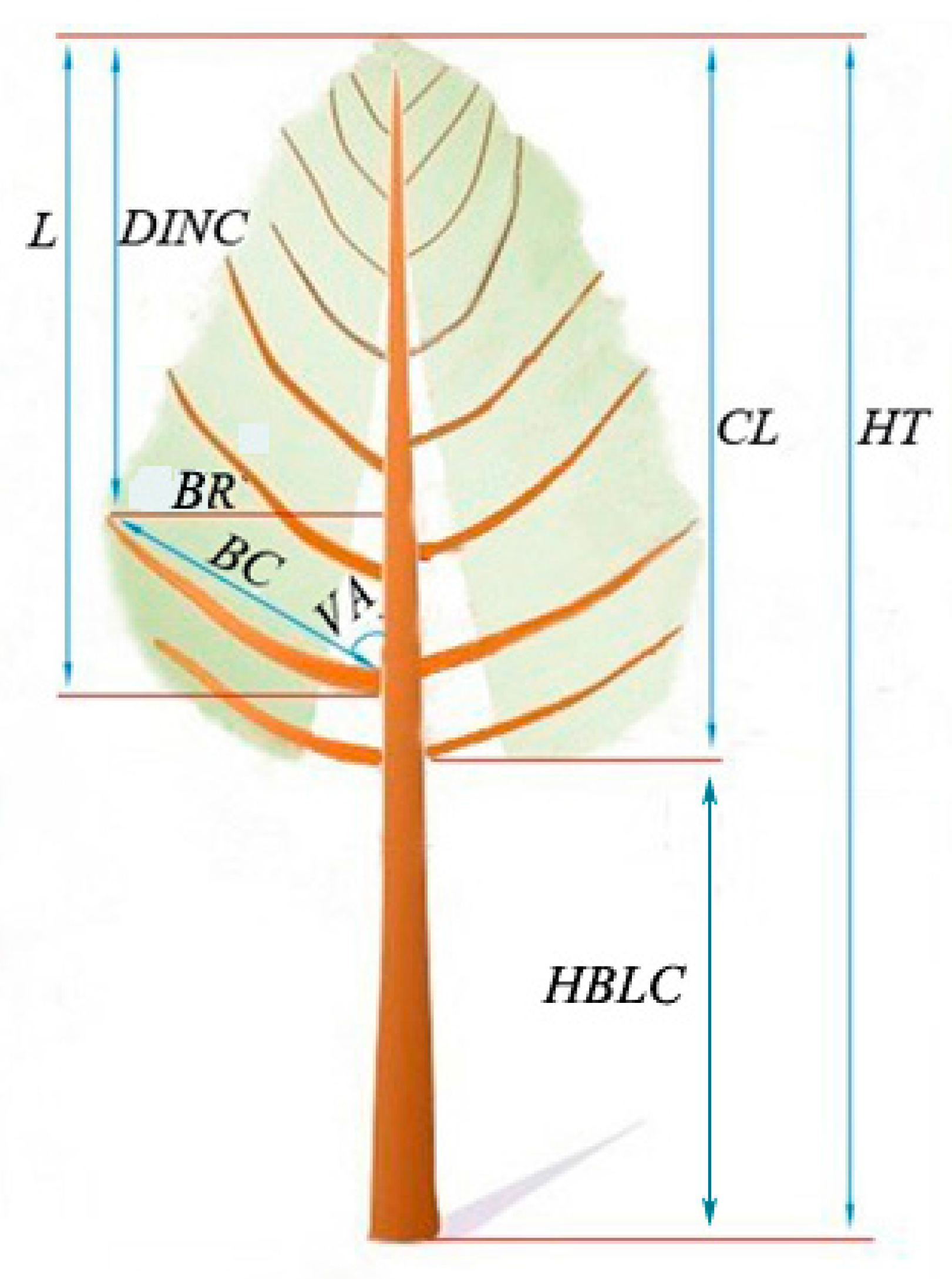
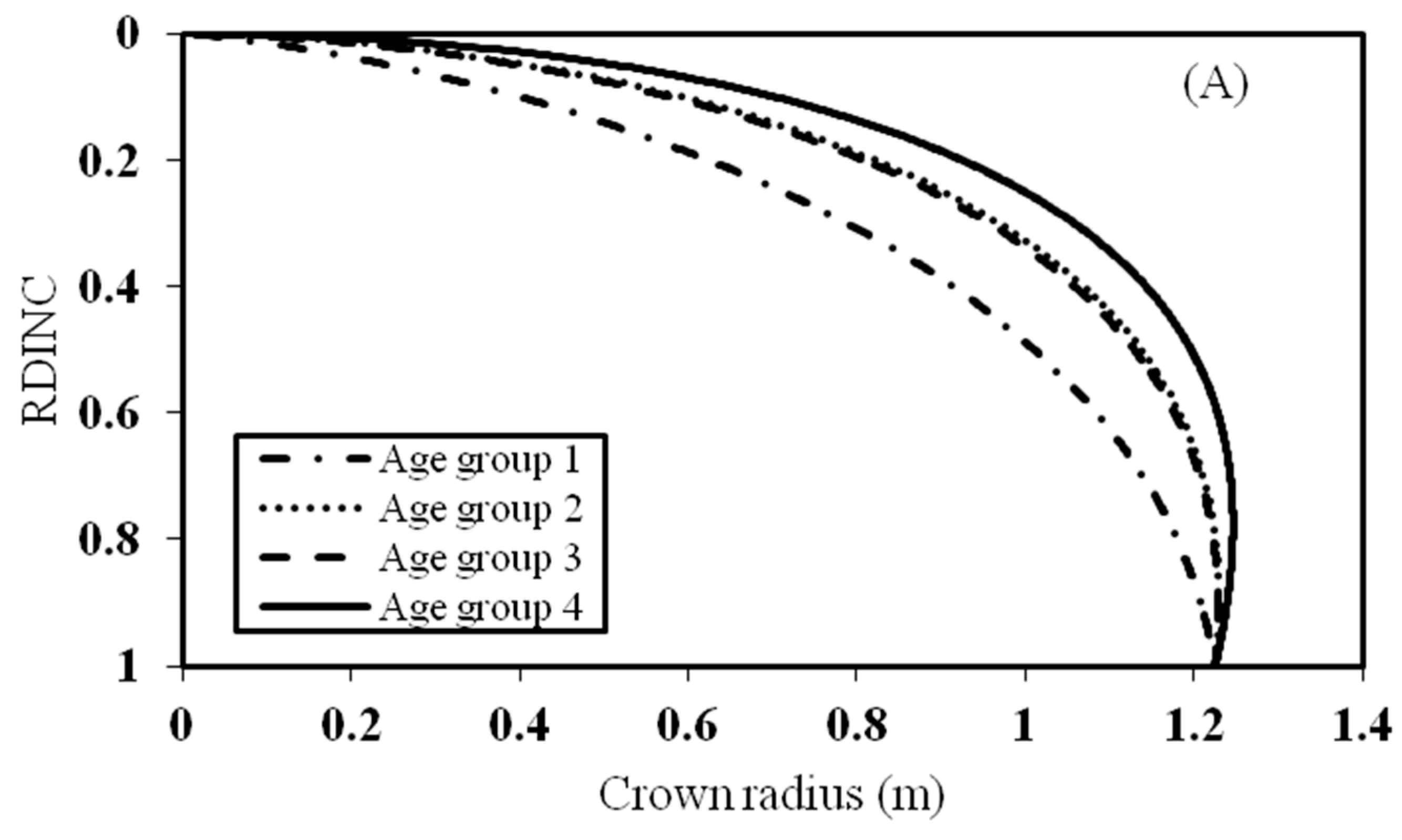
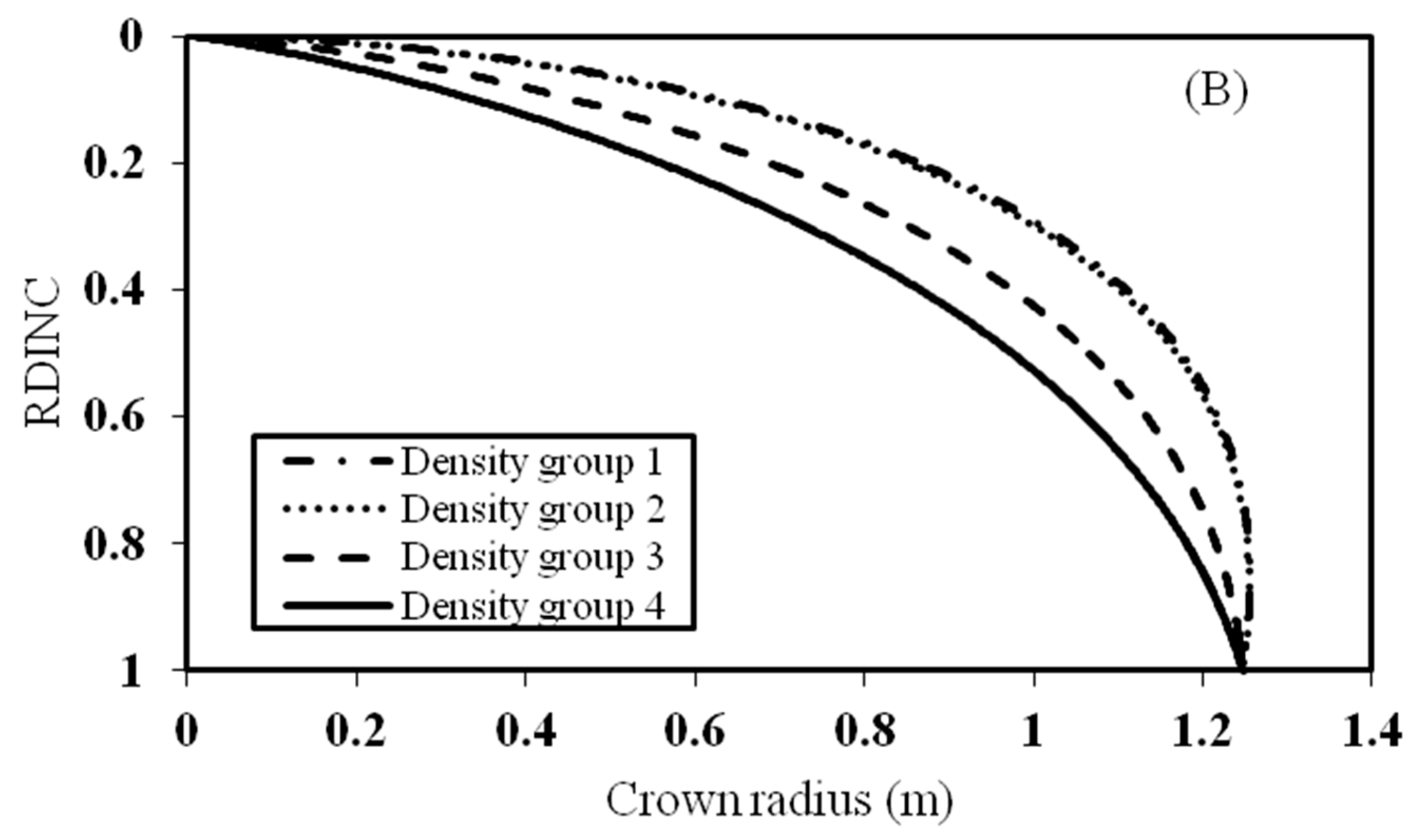
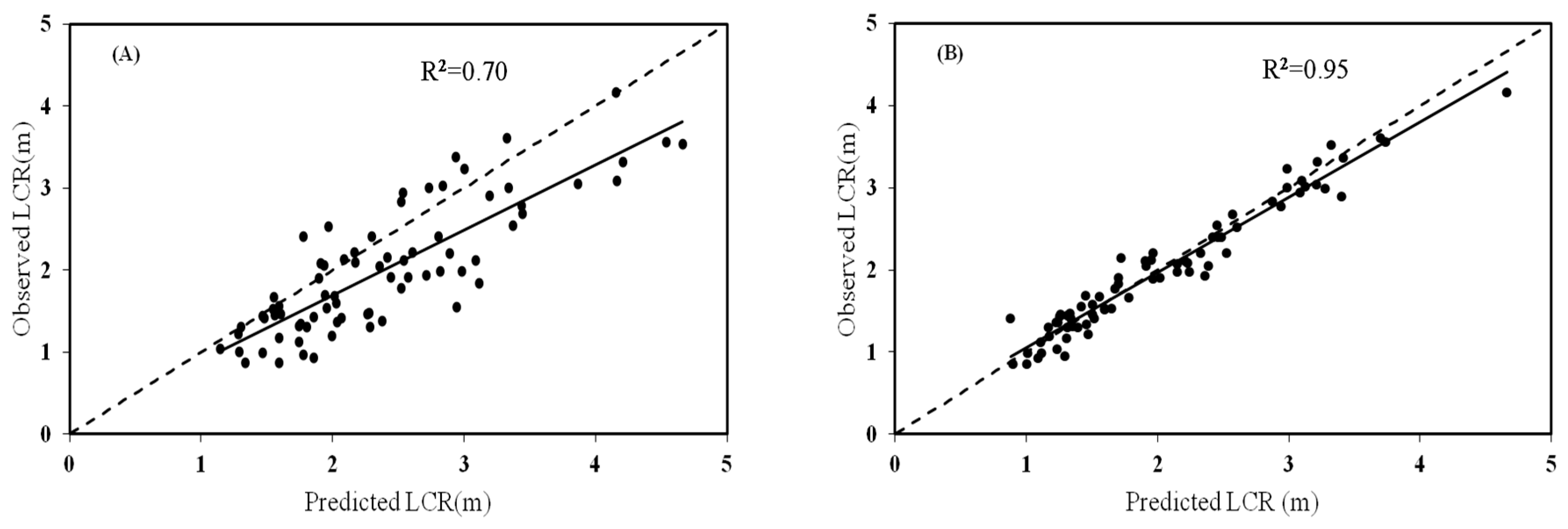
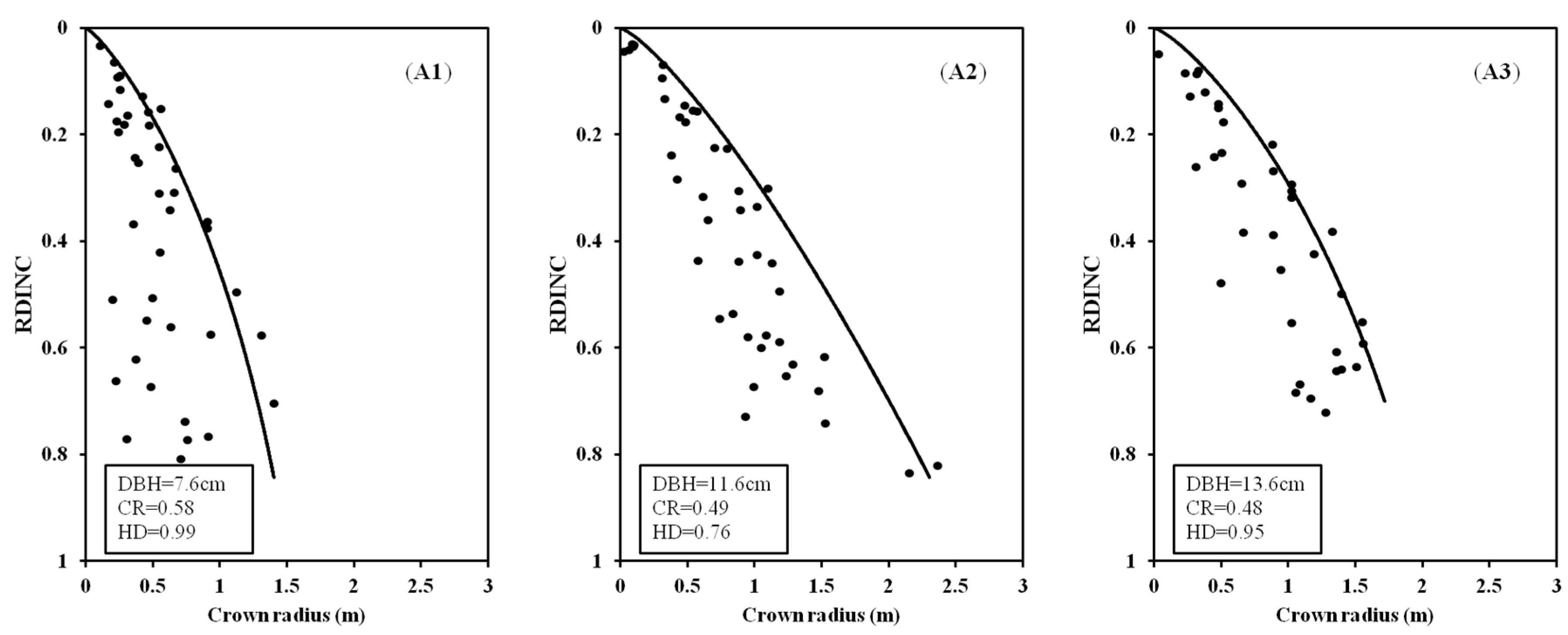

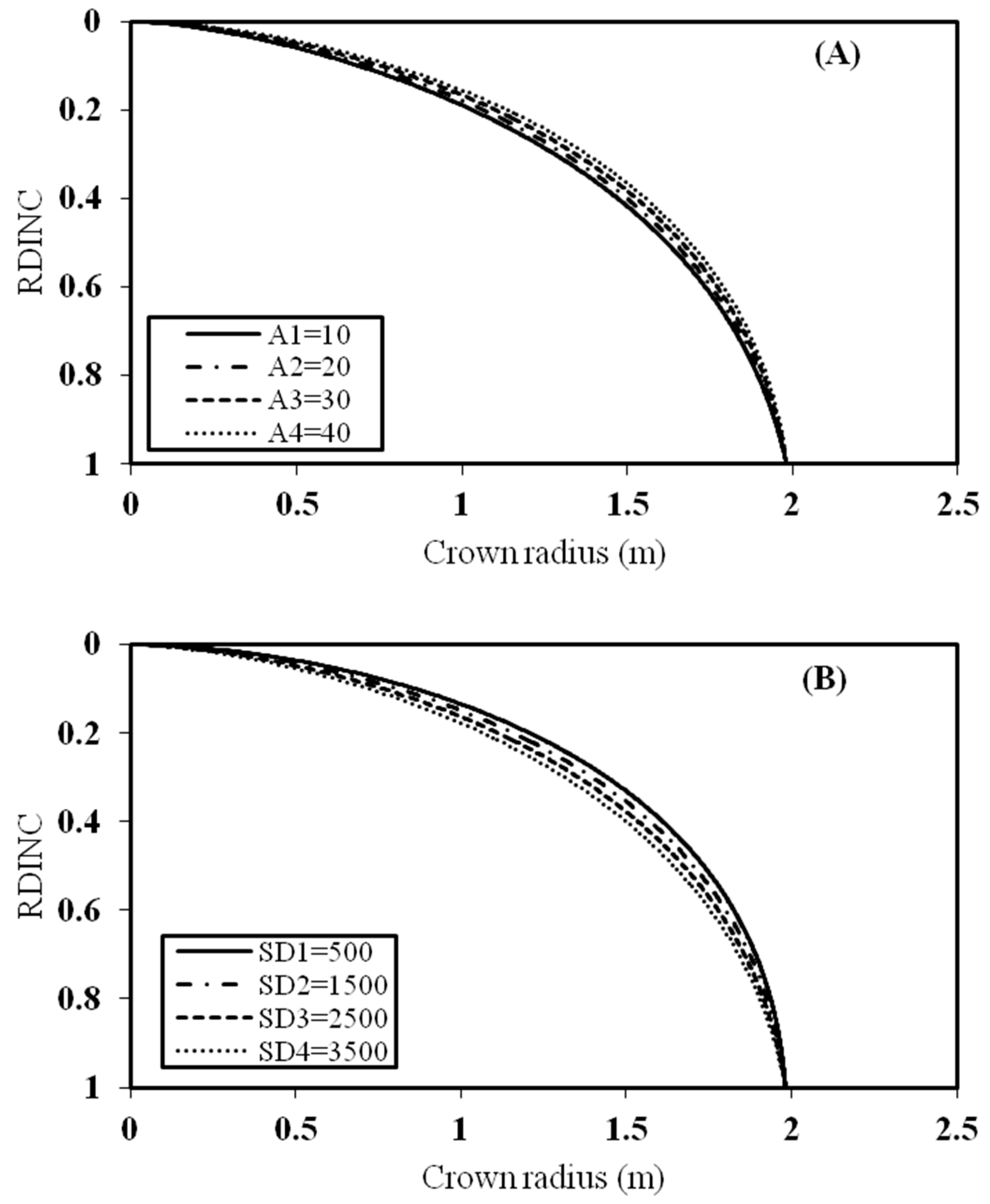

| Plot Number | Stand Age (Year) | Stand Density (Trees ha−1) | Mean DBH (cm) | Mean Tree Height (m) | Stand Volume (m3 ha−1) | Stand Basal Area (m2 ha−1) | Numbers of Sample Trees |
|---|---|---|---|---|---|---|---|
| 1 | 42 | 385 | 29.1 | 18.2 | 221.9 | 25.81 | 5 |
| 2 | 42 | 650 | 23.6 | 16.9 | 227.2 | 28.86 | 5 |
| 3 | 26 | 783 | 15.2 | 8.6 | 100.1 | 14.99 | 5 |
| 4 | 33 | 1883 | 13.3 | 13.9 | 168.8 | 27.11 | 5 |
| 5 | 18 | 3633 | 8.6 | 5.7 | 117.0 | 22.37 | 5 |
| 6 | 38 | 1025 | 19.1 | 15.4 | 220.4 | 30.33 | 5 |
| 7 | 44 | 1640 | 19.0 | 21.1 | 347.7 | 47.98 | 5 |
| 8 | 33 | 3840 | 10.6 | 9.9 | 163.9 | 28.62 | 5 |
| 9 | 43 | 1100 | 20.1 | 16.5 | 264.3 | 35.73 | 5 |
| 10 | 31 | 2025 | 13.4 | 11.7 | 192.5 | 30.33 | 5 |
| 11 | 46 | 450 | 29.6 | 20.7 | 287.0 | 32.86 | 5 |
| 12 | 38 | 1220 | 19.2 | 16.0 | 267.9 | 36.65 | 5 |
| 13 | 45 | 1217 | 21.0 | 19.5 | 344.0 | 44.36 | 5 |
| 14 | 20 | 3950 | 9.7 | 7.7 | 77.7 | 31.01 | 5 |
| 15 | 12 | 2350 | 7.1 | 4.3 | 36.2 | 9.62 | 6 |
| Statistics | Tree Variables (N = 76) | Branch Variables (N = 3658) | |||||
|---|---|---|---|---|---|---|---|
| DBH (cm) | HT (m) | CL | BL (cm) | BC (cm) | VA (°) | BD (mm) | |
| Mean | 17.9 | 14.3 | 5.4 | 130 | 121 | 47 | 2.02 |
| Std | 7.2 | 5.2 | 1.6 | 88 | 82 | 16 | 1.10 |
| Min | 6.0 | 3.5 | 2.6 | 3 | 3 | 10 | 0.09 |
| Max | 34.5 | 22.5 | 10.9 | 536 | 521 | 150 | 7.16 |
| Crown | Models | Power-Exponential Equation | Modified Kozak Equation | Simple Polynomial Equation |
|---|---|---|---|---|
| Total tree | Ra2 | 0.79 | 0.77 | 0.76 |
| RMSE | 0.3544 | 0.3675 | 0.3722 | |
| AIC | 762 | 835 | 858 | |
| Mean error | 0.0065 | 0.0065 | 0.0079 | |
| Mean absolute error | 0.2579 | 0.2664 | 0.2717 | |
| Light crown | Mean error | 0.0224 | 0.0209 | 0.0206 |
| Mean absolute error | 0.2467 | 0.2511 | 0.2588 | |
| Shade crown | Mean error | −0.1155 | −0.1039 | −0.1357 |
| Mean absolute error | 0.3436 | 0.3835 | 0.3713 bottom boder |
| Dummy Variables | Parameters | a1 | a2 | a30 | a31 | a32 | a33 | a4 | a5 |
|---|---|---|---|---|---|---|---|---|---|
| Stand age | Estimates | 0.3283 | 0.8064 | −0.1450 | −0.4671 | −0.4477 | −0.6057 | 0.4686 | −1.3186 |
| Std | 0.0296 | 0.0768 | 0.1175 | 0.1605 | 0.2065 | 0.1803 | 0.2818 | 0.2936 | |
| Stand density | Estimates | 0.3385 | 0.7571 | −0.4034 | −0.3886 | −0.1364 | 0.1067 | 0.4734 | −1.3342 |
| Std | 0.0296 | 0.0752 | 0.1539 | 0.2087 | 0.1148 | 0.1747 | 0.2752 | 0.2841 |
| Models | R2 | Var(εp) | [E(εp)]2 | MEP | MAEP |
|---|---|---|---|---|---|
| M3 | 0.9380 | 0.2291 | 0.0017 | 0.0388 | 0.1626 |
| q = 0.90 | 0.8789 | 0.2351 | 0.0510 | 0.2280 | 0.2312 |
| q = 0.95 | 0.9342 | 0.2312 | 0.0046 | 0.0668 | 0.1635 |
| q = 0.99 | 0.7987 | 0.3446 | 0.0577 | −0.2400 | 0.3187 |
| q = 0.95 (qrLMM) | 0.9431 | 0.2190 | 0.0026 | −0.0545 | 0.1458 |
| Random Effect | AIC | BIC | HQ | logLike |
|---|---|---|---|---|
| b1 | 1091 | 1130 | 1106 | −537 |
| b2 | 1399 | 1438 | 1414 | −691 |
| b1, b31 | 1064 | 1109 | 1081 | −523 |
| b1, b31, b4 | 1036 | 1104 | 1062 | −504 |
| Parameter | b1 | b2 | b31 | b32 | b33 | b4 | b5 |
|---|---|---|---|---|---|---|---|
| Estimates | 0.4084 | 0.6081 | 0.1240 | −0.0079 | 0.0001 | 1.2039 | −1.6362 |
| Std | 0.0126 | 0.0358 | 0.0783 | 0.0029 | 0.0000 | 0.1353 | 0.1461 |
© 2017 by the authors. Licensee MDPI, Basel, Switzerland. This article is an open access article distributed under the terms and conditions of the Creative Commons Attribution (CC BY) license (http://creativecommons.org/licenses/by/4.0/).
Share and Cite
Sun, Y.; Gao, H.; Li, F. Using Linear Mixed-Effects Models with Quantile Regression to Simulate the Crown Profile of Planted Pinus sylvestris var. Mongolica Trees. Forests 2017, 8, 446. https://doi.org/10.3390/f8110446
Sun Y, Gao H, Li F. Using Linear Mixed-Effects Models with Quantile Regression to Simulate the Crown Profile of Planted Pinus sylvestris var. Mongolica Trees. Forests. 2017; 8(11):446. https://doi.org/10.3390/f8110446
Chicago/Turabian StyleSun, Yunxia, Huilin Gao, and Fengri Li. 2017. "Using Linear Mixed-Effects Models with Quantile Regression to Simulate the Crown Profile of Planted Pinus sylvestris var. Mongolica Trees" Forests 8, no. 11: 446. https://doi.org/10.3390/f8110446





